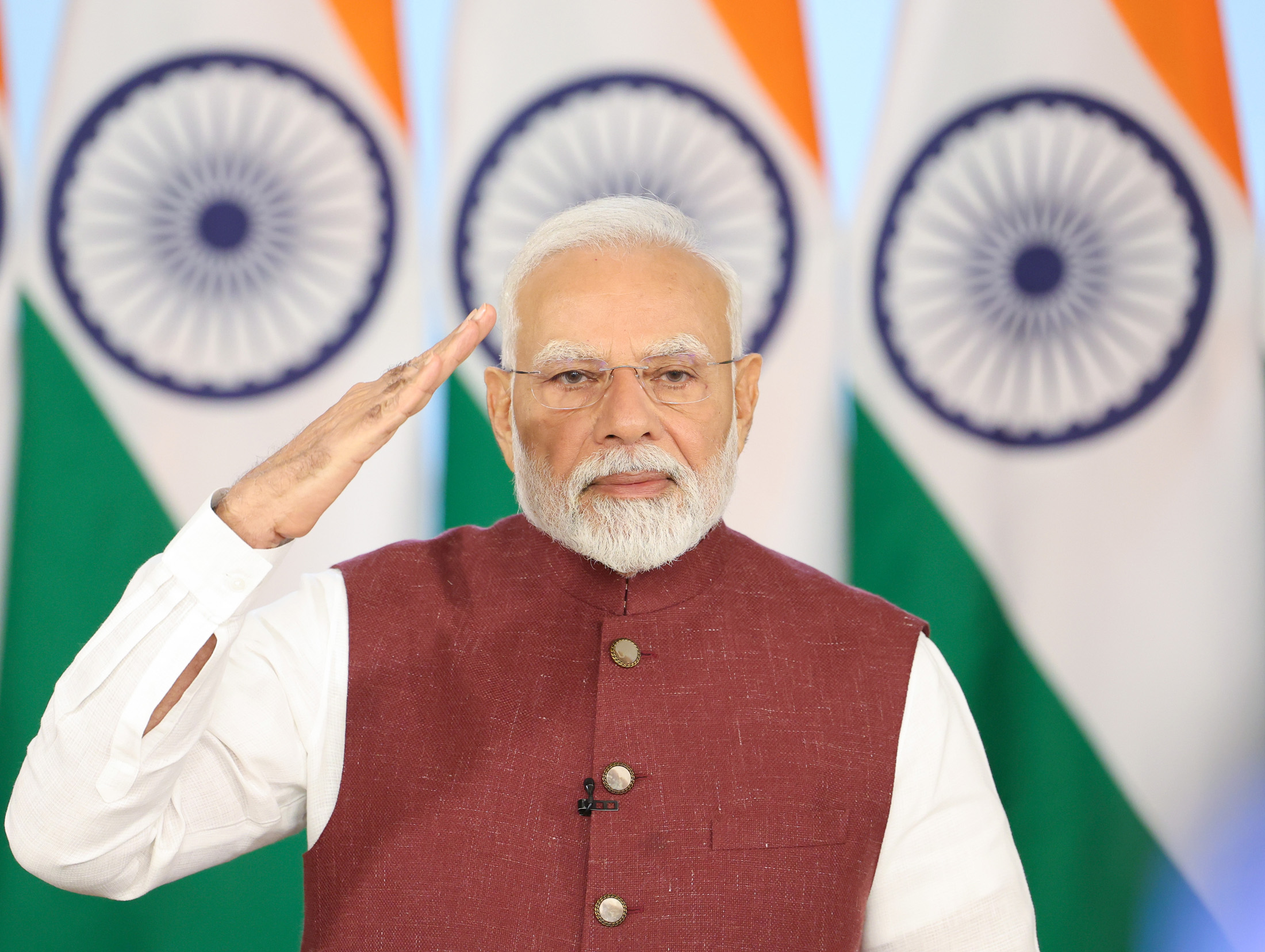The success of Operation Sindoor and the Modi Government’s new doctrine towards Pakistan can be understood clearly only when we compare it with the hesitancy of Manmohan Singh Government in the aftermath of 26/11 Mumbai attack in 2008. This tectonic shift in the approach towards Pakistan demonstrated through Operation Sindoor should not be seen as an isolated and one time incident. It is a manifestation of a strong timeline which will go deep into the diplomatic and strategic studies in the future. In this article, we are trying to analyze the origin of the operation, its evolution, and its calibration and what prompted the operation to become the new normal in the Indo-Pak relationship.
Ray of Hope: On the evening of 26th May 2014 in the forecourt of the Rashtrapati Bhavan, India witnessed an unprecedented scenario, when the Heads / Representatives of the South Asian Association for Regional Cooperation (SAARC) Nations attended Prime Minister Narendra Modi’s swearing-in-ceremony. And what made it more unique was the presence of Prime Minister of Pakistan Nawaz Sharif, who accepted the invitation, promptly participated and shook hands with PM Modi during the ceremony. Diplomats across the world nations and experts in strategic studies viewed this incident as PM Modi’s outreach initiative to strengthen the relationship with neighbor nations, particularly Pakistan. PM Modi who assumed his office newly wanted to assess the approach of Pakistan in the changed dynamics. Based on the same he wanted to shape his future policy towards Pakistan subject to the reciprocation from the other side. Following this there were continuous mutual diplomatic engagements both at official and informal levels. In July 2015, despite ceasefire violations on the border, Mr. Nawaz Sharif sent mangoes to PM Modi through official channels as a goodwill gesture. This was followed by PM Modi’s unprecedented and surprise visit to Lahore on 25th Dec 2015, to attend the wedding of Pakistan PM Nawaz Sharif’s granddaughter.
Pathankot – Bridges Burnt: However, barely a week later, on 2nd Jan 2016, there was a Jihadi terror attack on our Airbase, situated at Pathankot, Punjab, killing about 8 of our soldiers. The subsequent combing operation ended on 5th Jan 2016, until all the 4 terrorists involved were neutralized. This led to the breakdown of the relationship with Pakistan, which PM Modi initiated immediately after assuming office. It also exposed Pakistan’s unwillingness to opt the diplomatic route to maintain tranquility in the region. Still India chose not to end the diplomatic relationship with Pakistan abruptly. As an opportunity to restore the relationship, India agreed to allow a Joint Investigation Team (JIT) from Pakistan to visit the attack site and assured assistance them on their investigation. Pakistani Investigators not only failed to make use of the opportunity but sabotaged it by stating that this was a staged attack by the Indian Government to malign Pakistan. Later in August 2016, the then External Affairs Minister Sushma Swaraj reflecting Indian stance, categorically stated that ‘Terror and Talks cannot go hand-in-hand.’
Uri – The Shishupal Moment: However, there was no letup in infiltration by terrorists from Pakistan side, when in the same year Sep 18th, our Army brigade headquarters in Uri near the Line of Control (LoC), J&K was attacked by the Pakistan based Jaish-e-Mohammed (JeM) terrorists killing about 19 of our soldiers. It was at this moment, PM Modi led Indian Government concluded that Pakistan would not understand the diplomatic language and decided punitive action by conducting a surprise surgical strike. On 28th Sep 2016, Indian Director General of Military Operations (DGMO) informed the press that Indian Army crossed the LoC and attacked the terrorist launch pads by causing significant destruction to the terrorists in the Pakistan Occupied Kashmir (POK). It was a huge risk taken by the Indian side, to ensure a successful operation without any causality for the Indian forces involved in the operation. Instead of measuring the quantum of loss either side, it was considered a defining moment, when India shed its passive posture and demonstrated its strong intent to adopt retaliatory approach against the misadventure from the Pakistan side.
Pulwama – Brazen Misadventure: Pakistan failed to read the message under the changed dynamics and PM Modi’s revised approach towards it. Another misadventure attempted on 14th Feb 2019, when a suicide attack was carried out in Pulwama, Jammu & Kashmir (J&K) on a bus carrying the Central Reserve Police Force (CRPF) personnel. Around 40 CRPF jawans across 16 states were killed. JeM took responsibility for this attack and this incident once again shook and awakened the Nation’s resolve to avenge the wrong doers. India revoked Pakistan’s Most Favoured Nation (MFN) status. Further in alignment to the sentiments and expectations of the Nation, India raised the bar of retaliation, further by undertaking an airstrike in Balakot on 26th Feb 2019, targeting terrorist camps deep inside Pakistan. JeM training camps were the primary target, and a large number of terrorists were killed. This was seen as a significant escalation not only in India’s retaliatory action but also in its precision and strategy.
Abrogation of Art.370 – Sanjeevani for J&K’s life: After winning 2nd term in 2019, PM Modi decided to abrogate Art.370 not only as a part of his party’s ideological commitment, but also as a long-term strategy in the interest of J&K. PM Modi had the clarity that without addressing the domestic issues of the state, designing a comprehensive strategy against Pakistan would not be sustainable.
In this regard, in Aug 2019, his Government passed the resolution in both the Houses of Parliament to abrogate Art.370 thereby making the J&K state as 2 union territories – J&K and Ladakh. Later in Dec 2023 the Government’s decision was upheld by the 5-judge bench of the Supreme Court through a unanimous judgement. Meanwhile, apart from local body elections, assembly elections were also conducted peacefully in the state to establish democracy at all levels. Through the abrogation of Art.370, PM Modi aimed to improve the law-and-order situation in the state thereby ending stone pelting incidents. He also felt that through this action, the separatist leaders will be removed from interfering in the politics of the state thereby enabling the people to access the benefit of Government policies including reservation.
The attempt of the Government began to show the desired results. The Economic survey presented in J&K Assembly in March 2025 stated that the state GDP is expected to grow by 7.06% in FY2024-25 and unemployment is expected to decline to 6.1% since 2019. The size of J&K’s economy is estimated at INR 2.65 lakh crore and its real GSDP at INR1.45 lakh crore. Tourists who used to prefer European countries, began to choose J&K as their favorite destination. In 2024, tourism was found soaring to an all-time high of 2.36 crore which includes foreign tourists to Kashmir’s Dal Lake, landscapes, and pilgrims to Amarnath and Mata Vaishno Devi shrines.
Operation Sindoor – Modi’s New Doctrine: In a sinister move to defeat India’s long-term vision in J&K and to recreate its earlier designs, Pakistan opted for a more unethical and inhuman strategy. On 22nd April 2025, a group of innocent tourists who went to Pahalgam town of Anantnag district, J&K were targeted. They were separated based on their religion, and the males of the group were brutally killed in front of their wives and children. 26 civilians from 15 states including 1 Nepali citizen lost their lives. The Resistance Front (TRF) affiliated with Lashkar-e-Taiba (LeT) claimed responsibility for the heinous crime. Taking a cue from its earlier experiences, Pakistan anticipated retaliation from the Indian side, and it began to take precautionary measures. India as a part of series retaliatory measures, suspended Indus Water treaty that was in force since 1960. On 7th May 2025, India carried out Operation Sindoor against Pakistan. The operation was held in both POK and mainland Pakistan targeting high profile terror headquarters resulting in success. This was followed by a conflict that lasted for 3 days. Indian army not only defended our entire western borders spreading from J&K to Gujarat through our integrated defense system but also caused severe damages to the military installations especially air bases across main sites inside Pakistan. On 10th May 2025, an understanding of ceasefire was announced based on the request from the Pakistani side after the call from the Pak DGMO to his Indian counterpart.
On 12th May 2025, in his address to the nation PM Modi (wearing a jacket with the colour of Sindoor) stated that Operation Sindoor is only suspended, and future actions will be measured based on the attitude adopted by Pakistan. He unveiled a new doctrine towards Pakistan. As per the same,
1.If there is a terrorist attack on India, a fitting reply will be given based on India’s terms.
2.India will not tolerate any nuclear blackmail.
3.India will not differentiate between the Government sponsoring terrorism and the masterminds of terrorism – India going forward will consider any terror activity from Pakistan as an act of war.
He also stated that ‘Terror and talks cannot go together. Terror and trade cannot go together. Water and blood cannot flow together. And if there are any talks with Pakistan it will be on Terrorism and POK.’ There are some subtle messages from PM Modi not only to Pakistan but also to the entire the world.
1.The name Sindoor was selected as it is emotionally connected to our citizens, especially women.
2.Technology and strategic integration were key aspects of the operation.
3.The operation was originally limited to terrorist camps and facilities without any escalation plans.
4.In the operation, sites of attack were carefully selected based on high profile targets.
5.India was aware of Pak’s retaliation plans and got itself prepared with its strong defense system in the entire western front.
6.The operation not only demonstrated the power & precision of the Indian weaponry but also exposed the futility of the foreign weapons used by Pakistan. 7.Press conference address by women officers from Indian Army and Indian Air Force was to demonstrate India’s ‘Nari Shakthi.’
8.The escalation was carefully calibrated first to Pak’s defense system and then to their air bases.
9.All army operations were substantiated with satellite images & media briefings. 10.India did not acknowledge and accept any third-party interference in its affairs and operation.
11.The Indus Water Treaty continues to remain suspended despite the pause of military operations.
PM Modi, by unveiling his doctrine made it clear the approach towards Pakistan is the new normal. The Modi doctrine is not a knee jerk reaction but is a result of a consistent evolution from 2014 to 2025. From surgical strikes to air strikes to Operation Sindoor, the India continuously raised its scale of aggression, distance, and intensity. After the 1971 Indo-Pak war, India crossed the LoC multiple times as a part of the new doctrine. And this operation is going to shape our future politics by marking a benchmark in this direction. The success of Operation Sindoor will go down in history, politics, diplomacy, and strategic studies.
Jai Hind!
(The views expressed are the author's own and do not necessarily reflect the position of the organisation)


